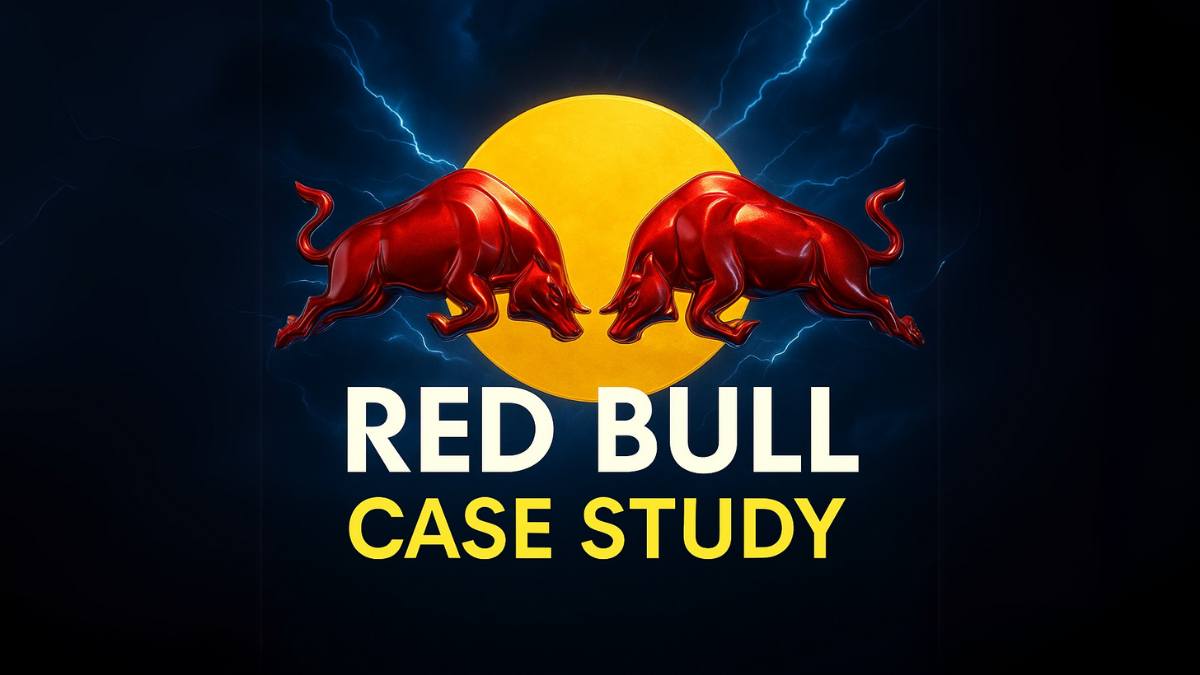This isn’t just the story of an energy drink. This is how a small beverage brand turned itself into a global media empire, built a culture, and pretty much created a product category that didn’t even exist before.
If you’re a marketer or entrepreneur, the Red Bull case study is one you have to study. Why?
Because it teaches you one of the biggest truths in modern marketing:
People don’t just buy products – they buy meaning, identity, and belonging.
By the end of this blog, you’ll understand how Red Bull:
- Built an entire lifestyle brand around a single product
- Used content marketing before it was even a buzzword
- Created global events and media properties that kept competitors irrelevant
And of course, we’ll also unpack the practical takeaways you can steal for your own brand.
Let’s dive in.
Table of Contents
The Birth of Red Bull: A Brand Inspired by Asia
Before Red Bull was breaking world records or sponsoring Formula 1 teams, it started in a very unexpected place – Thailand.
Back in the 1980s, Dietrich Mateschitz, an Austrian marketing executive, discovered a popular Thai drink called Krating Daeng. It was sweet, syrupy, and very different from what Western consumers were used to.
But Mateschitz saw something others didn’t: potential.
He didn’t just want to sell a Thai drink in Europe – he wanted to create a whole new category.
And that’s exactly what happened.
With some tweaks to the formula (less sweetness, more carbonation) and brilliant marketing, Red Bull was born. And suddenly, “energy drink” wasn’t just a new product – it was an entire category that they owned.
Building a Brand Identity: More Than Just a Drink
This is where Red Bull’s real genius kicks in.
They didn’t just launch a drink. They launched an identity.
- Red Bull wasn’t for everyone. It was for doers. For the adventurous. For the people who said yes to the crazy idea.
- They built a brand around energy, adrenaline, and possibility.
But it wasn’t easy. Imagine trying to explain to someone in 1987 what an “energy drink” even was. There was nothing to compare it to.
So, how did they break through?
Memorable messaging.
“Red Bull gives you wings.”
Not just catchy – but psychological. It promised more than caffeine. It promised possibility, daring, and an edge in life.
They didn’t just market a drink. They marketed aspiration.
Also Read: Apple Marketing Case Study
Red Bull’s Marketing Mastery: Content Before It Was Cool
Here’s where things get wild.
Red Bull didn’t just run ads like every other beverage brand. They became the media.
Red Bull Media House → films, documentaries, extreme sports content. They basically created a media empire to promote their drink without even mentioning the drink.
Let that sink in: They marketed by creating entertainment.
And then there’s the guerrilla marketing – genius moves like:
- Giving away free Red Bulls at college events, nightclubs, and music festivals.
- Specifically targeting trendsetters – DJs, athletes, influencers – before the term “influencer marketing” even existed.
Suddenly, people wanted to be seen with a Red Bull. It wasn’t just a drink anymore; it was a signal.

If you want to learn how to build strategies like this for your own brand, you should definitely check out Young Urban Project’s Advanced Digital Marketing Course. It dives deep into strategies like this, but adapted for today’s platforms.
Sponsorships & Product Placement: Selling Without Selling
Red Bull didn’t stop at just sponsoring sports.
They bought teams.
→ Red Bull Racing in Formula 1 wasn’t just a logo slapped on a car. They owned the whole team, built their own legacy in F1, and dominated headlines for years.
And then… Felix Baumgartner happened.
Remember the guy who literally jumped from the edge of space?
That wasn’t NASA. That wasn’t the military. That was Red Bull.
No product pushing. Just pure spectacle. But everyone knew who made it possible.
This was content marketing on steroids – and every brand’s dream case study.
Also Read: Uniqlo Case Study
Red Bull’s Role in Extreme Sports: Lifestyle Branding
Why did Red Bull focus so much on extreme sports?
Because extreme sports = energy, risk, adrenaline → the perfect reflection of what Red Bull wanted its brand to feel like.
→ Instead of competing with Coke or Pepsi on their turf, they played an entirely different game.
And here’s the lesson:
Position your brand in a place where your competitors can’t even follow.
For Red Bull, that was the adrenaline-fueled lifestyle space. And they owned it.
Also Read: Amul Case Study
Packaging as a Marketing Tool: Selling an Experience
Let’s talk about that slim blue-and-silver can.
It’s not just packaging – it’s positioning.
Most sodas came in short, stubby cans. Red Bull went sleek. Tall. Almost… European cool.
And because it looked premium, they could charge premium.
- Smaller can → Higher price → More exclusivity.
Suddenly, buying a Red Bull wasn’t about thirst. It was about image.
Lesson for marketers? Design sells experience before product. People drink with their eyes first.
Also Read: Netflix Case Study
Retail Distribution Strategy: Owning the Shelves
Getting into stores wasn’t easy for Red Bull in the beginning. Retailers didn’t know where to put this “energy drink.”
Is it a soda? A supplement? A sports drink?
So Red Bull hacked it.
They focused on availability in the right places:
- Nightclubs
- College events
- Gyms
- Airports
→ Places where tired, active, adventurous people hung out.
Instead of fighting for shelf space with Coca-Cola in grocery stores, they won the battle at the point of craving.
That’s next-level placement thinking.
Also Read: Starbucks Case Study
Innovation Beyond the Drink: Red Bull as an Ecosystem
Here’s the crazy part:
Red Bull barely innovated on the drink itself.
No flavors for years. No sugar-free for a long time. Just that one iconic taste.
But where they did innovate? Experiences.
They built:
- Red Bull Music Academy
- Red Bull Cliff Diving
- Red Bull Air Race
- And of course, that Space Jump we can’t stop talking about.
They weren’t selling drinks anymore. They were selling moments.
→ If you want to build brand longevity, focus less on what’s in your product – and more on what your product makes people feel.
Also Read: Coca-Cola Case Study
Brand Evolution: Logo & Visual Identity
Ever noticed that Red Bull’s logo has barely changed since the start?
→ Two bulls charging at each other. Same colors. Same bold typeface.
Why?
Because recognition beats creativity in branding.
Subtle tweaks, yes. Local adaptations for certain markets, sure. But overall, it’s been Red Bull for decades.
When you own a shape, a color combo, or a symbol – don’t mess with it.
Consistency builds trust.
Also Read: McDonald’s Case Study
Target Market: The Psychology of Selling Energy
Red Bull didn’t go after everyone.
They went after:
- Young people
- Active people
- People who wanted to be adventurous, even if they weren’t
It’s not just about selling a drink. It’s about selling an identity.
→ “If I drink this, I’m the kind of person who does cool stuff.”
And over time, they broadened that audience by owning media that appealed to all kinds of adventure-seekers, not just athletes.
So now, even if you’re not skydiving on weekends, sipping a Red Bull might make you feel like you could.
Also Read: Zara Case Study
Key Takeaways for Marketers: Lessons from Red Bull’s Journey
Alright – let’s break down the practical stuff.
What can you, as a marketer, actually steal from the Red Bull case study?
1. Create culture, not just content.
→ Give people something to belong to.
2. Your product is secondary. The experience is the product.
→ People don’t just drink Red Bull. They wear it.
3. Be the category creator.
→ No one knew what an energy drink was. Red Bull taught them.
4. Own media. Don’t just buy it.
→ Building your own media platforms means controlling your narrative.
This isn’t about being the loudest brand – it’s about being the brand they can’t ignore.
Also Read: Myntra Case Study
Conclusion
Red Bull’s story isn’t about selling drinks. It’s about building a movement. They didn’t just launch a product – they created an entirely new category, then used media, events, and culture to dominate it.
From owning sports teams to launching people into space, Red Bull showed that modern marketing is about much more than catchy ads. It’s about creating experiences that people want to be part of.
Their success proves that consistency, storytelling, and thinking bigger than the product itself are what separate average brands from iconic ones.
If you’re building something – whether it’s a personal brand, a startup, or a full-scale company – this is the blueprint to study. Not to copy, but to inspire you to think in systems, not just sales.
Red Bull didn’t just give people wings. They built the runway too.
FAQs: Red Bull Case Study
Who founded Red Bull, and where did the idea come from?
Dietrich Mateschitz discovered Krating Daeng, a Thai energy drink, and adapted it for Western tastes. That’s how Red Bull started – with a sharp eye for opportunity and smart marketing instincts.
What makes Red Bull’s marketing different from other brands?
They didn’t just buy ads. They built a whole media empire, creating original content and owning platforms where their audience spent time. Red Bull became a media company first, beverage brand second.
How did Red Bull benefit from extreme sports?
Extreme sports perfectly matched Red Bull’s high-energy brand persona. Associating with these events helped position them as daring, adventurous, and different from mainstream beverage competitors like Coca-Cola or Pepsi.
Why is Red Bull’s pricing considered premium?
It’s all about perceived value. The sleek can, targeted distribution, and association with cool, adventurous lifestyles allowed Red Bull to price itself higher than competitors – and customers were happy to pay.
What can digital marketers learn from Red Bull?
The biggest lesson: Don’t just sell products – build worlds around them. Focus on creating stories, events, and content that make your brand memorable and emotionally connected with your target audience.
How has Red Bull stayed relevant globally?
By sticking to a consistent visual identity while constantly innovating around brand experiences. Red Bull evolved from just energy drinks to owning entire cultural spaces like extreme sports, music, and adventure.

